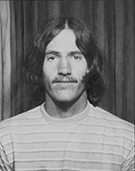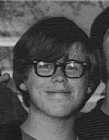|
Jack Knolty.Although at this point in our story he has departed from the North-State music scene he will play an important part in the group's story both as mentor-spiritual advisor-debaucher to the young Harvey and sound technician-master carpenter for the band.  Knolty, an athletic man-child. On first meeting one might guess him to be an amateur boxer (his nose was flattened from a high dive into shallow water at a local swimming hole which did not leave him un-handsome), grandnephew of the silent era film comedian Harold Lloyld.Son of Hollywood stunt rider parents. Slim Pickens would stop by the Knolty family boatshop-ranch to say hello and reminisce. The carpentry skills his father taught him would come in handy when it came time to spruce up the stage gear with big powerful speaker cabinets which the scamps decided to festoon with the beloved American flag as grill cloth. Later Knolty would ply his expertise on the construction of the highly sought after though cumbersome Altec A-7 cabinet with it's patented curved plywood horn and exacting acoustically enhancing measurements. But at this point in time Knolty and his friend and former bandmate Chris Mayer were facing a life and death situation. Both were eighteen and the war in Viet-Nam was in need of young men who were not able to take advantage of the college deferments offered to those lucky enough to excel in academics and be awarded a scholarship or have parents wealthy enough to mortgage their sons into a 4 year college and hence out of the draft. No, only the patriotic, poor and ignorant would be taken. Ignorant? Yes, for there was one last option. Snowing the draft board. Pulling the wool over their eyes. Selling them a cock and bull story. Mayer would later enlist in the navy, as would another principal player soon to be met. Both would serve a short hitch and be granted a General Discharge.Not branded for life, but leaving enough taint to put any veteran of foreign wars on alert.  David Harvey.His dark curly hair, ruddy complexion and patrician nose told much of his aristocratic English heritage. Son of a well-established jeweler. City boy. While the others walked to school on dirt and gravel, through pastures and culverts, braving the attacks of the inbred offspring of the great depression immigrants who flocked to the area to work on Roosevelt's W.P.A. environmental disaster Shasta dam,"Prince Harvey" trotted to lessons on sidewalks paved of concrete and stepped down onto the street from a "curb". A strong work ethic prevailed within the Harvey clan and all family members were expected to work at "The Store" for which they were compensated. This compensation and the opportunity to purchase musical instruments from a wholesale catalogue at wholesale prices conspired to provide Mssr. Harvey with one "Harmony Rocket" electric guitar. This was no ordinary Harmony Rocket.It had three pickups with golden horseshoes inlaid in the pickup covers. An honor roll student. Some say gifted (he completed high school in a dizzying seven semesters). With the concentration and dedication of a catholic priest at high mass (the slap of the Nun's ruler in parochial school would condition the boy for his rocky journey through rock n' roll) he would play and re-play the records of his heroes until he could imitate every nuance of their performance often to the point of his ropy fingers bleeding from their tips. After Harvey deciphered the sounds of their favorite long players he would drill the musicians with the patience of a Nun until he was satisfied with the group's mimicry (a practice he would continue to employ when the shattered remnants of Ed Blake were reduced to a "Top 40" lounge act).  Robert Sell, Jr.. Part Indian. Expert Marksman with the eyes of an eagle. A star athlete in both baseball and track and field. These endeavors would soon conflict and eventually fall by the wayside, a great disappointment to his family, in favor of his interest in music. Son of a U.S. Marine who founded and ran a successful lumber business,"Bobby" as he was known within the family, did the work of a grown man at an age when most boys were barely able to tie their own shoelaces and skip to school without their mums holding their hands. He could drive a Peterbilt at ten. A forklift served as a tricycle for this young tough. An afternoon call to young "Bob" would elicit a terse "he's at the yard working"(and-in an unspoken but telepathically sent and received message- why aren't you out some where doing the same you lazy lay-about) from his brusque but kindly mother. Her boy could do no wrong where outsiders were concerned and she would fight many a battle with angry neighbors on his behalf. Hard work had its rewards too. One of these rewards was a professional drum set given to him by his mater and pater at the age of twelve. A pink champagne set of Rodgers drums with hand fashioned brass Avedis Zildjian cymbals.A set of drums even a grown man could be proud of. The bain of every young musician not of driving age in this semi-rural community was transportation. Robert, Jr.'s mother could always be counted on to ferry the young Sell and his cohorts to practice sessions in her always new Buick with implorations to be careful not to tear her upholstery with the jagged edges of their rock n' roll gear. Damage would eventually ensue but what the hell; a new Buick was only a few months away.  Steven Huff.Refugees of urban flight, the Huff family came to Redding in 1966 from the San Francisco bay area in search a haven free of youth gangs, racial conflict, and drugs (yes even in these innocent times gangs formed along ethnic backgrounds flourished and drug use-young Huff's only exposure was seeing a friend lying stupefied in a gutter after inhaling paint-now known ironically as "Huffing") only to be confronted by a culture twenty (some wags may claim one hundred) years behind the times. One can only imagine the adolescent Huff's howl of agony his first night in this sweltering outpost of humans who by living example defined the term "white trash", as the only rock n' roll radio station, KRDG, signed off the air at midnight. Pudgy and bespeckeled. Ding Dongs, Ho Ho's, Bugles and snack foods inspired by the race in space like Tang, Space Food Sticks, Poptarts, Instant Breakfast and even cereal with de-hydrated fruit that would resurrect with the addition of milk like Jesus on Easter Sunday were the co-conspirators in his tendency toward portliness. That and a daily routine void of physical activity. A typical day for the youngster consisted of a nap following school followed by a platter party, some snacks then dinner, chased with a long night of television with guitar in hand. Playing incessantly, mimicking the TV show themes and commercials of the era much to the consternation of his family he would hone his ear, the un-schooled musician's most valuable asset. Son of a telephone installer; a Ma Bell veteran who thought he had seen poverty in it's foulest incarnations while servicing the arteries of communication in the slums of Oakland, California. Nothing had prepared him for the Bosch-like tableau that stained his vision upon acceptance of an invitation to "come on in" by the poor Shasta County hill folk. What greeted him was squalor and misery beyond imagination. Long of hair and wearing tight "pegged" pants and "winkle picker" styled suede "Beatle Boots","the new kid in town" was promised by schoolyard prophets a severe beating immediately following his first day at school by the fists of an older boy from another school who would make it a point to stop by just to "kick his long-haired-pussy ass" thereby putting a stop to the advancement of the 20th century and defending Shasta County's warp in time. Only one thing would enable the young Huff to survive in this hostile environment guitar. To be precise a Harmony Rocket not unlike the Harmony Rocket owned by another fledgling fretman, David Harvey. This "Rocket" possessing only two
pickups and no golden horseshoe inlays but most certainly a capable
instrument. Redding, Shasta County, California, the United States of America.Though not a living entity this city and enviorns would play a crucial role in the fate of our young musical warriors. Located at the top (north) of the Sacramento (sack-a-tomatoes, as some prefer to pronounce it) Valley, Redding sits in a very comfortable and scenic geological Lazy-Boy.With Mount Shasta to the north, Mount Lassen to the east, and the Trinity Alps to the west something had to give. The south, though not without it's own brand of grandeur, was to be a formidable frontier of more than one hundred and fifty miles that presented itself as an insurmountable obstacle when it came time for escape, success, celebrity. Shasta County is named after 14,162 foot Mount Shasta." Shasta" is taken from either the Russian expression "Tchastal" referring to its white grandeur and magnificence or the name of an Indian tribe now known by the spelling "Shastan" or "Shastiki." One of the original counties when California became a state, Shasta County originally was "a vast principality stretching from the Oregon border on the north, to a line near present Red Bluff on the south, and from the Nevada border on the east, all the way to the Coast Range in the west." The first Europeans to exploit the area were Spanish-speaking and would travel up and down the Sacramento River, trading with local Indians. The first permanent European settlement was established in 1844 by Pierson B. Reading (pronounced Redding), an immigrant to California from the United States. By the good graces of Gobernador Micheltoreña, Reading was granted a vast domain stretching 19 miles in length and three miles wide along the west bank of the Sacramento River from Cottonwood Creek to Salt Creek north of what is now Redding.Reading established his seat slightly north of the confluence of Cottonwood Creek and the Sacramento River, and west of Goat Island, or Reading Island. Also of historic note is the only practical way in and out of this seemingly idyllic setting, U.S.Highway 99 (now mostly replaced by Interstate 5). First known as the Pacific Highway it was built in 1915 along stagecoach roads and rebuilt in the early twenties. It consisted of two 8 foot wide lanes with no median; shoulders were an afterthought in later years, and when vehicles attempted to pass each other, it could prove to be a life and death situation as our heroes would discover on their forays south to "The City", San Francisco (the well honed driving skills of Sell, Jr. would one day save both he and Huff's lives as an eighteen wheeler "driven" by a sleeping pill-popper bear down on them head on) to attend concerts by their favorite artists, shop for musical gear and records not to be found in their whistle-stop burg,and yes even once to perform for the erudite sophisticates of Berkeley.More about that later... Trips to "the city" were twenty four-hour outings captained by older boys with vehicles and inevitably led to "the drive home"; a four-hour ordeal usually begun after midnight (an overnight stay was a financial impossibility). Beyond the glow of civilization awaited a flat unswerving ribbon of asphalt fraught with monotany. A hypnotic highway that even in daylight offered nothing but fields and fences as candy for the eyes. |
PART 3
BACK